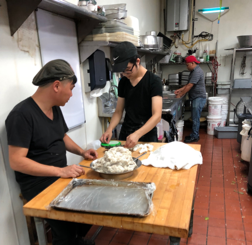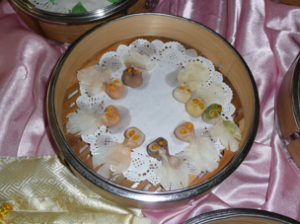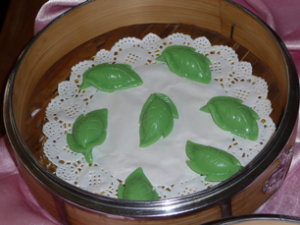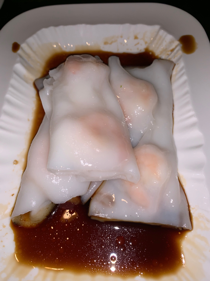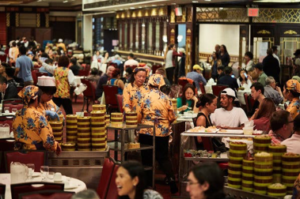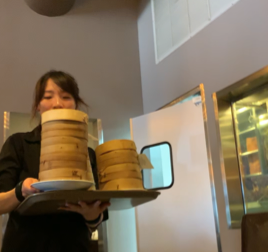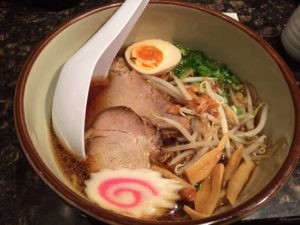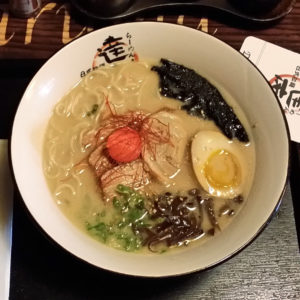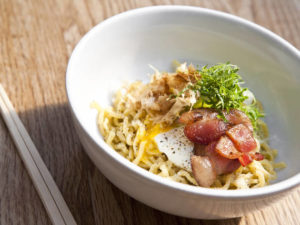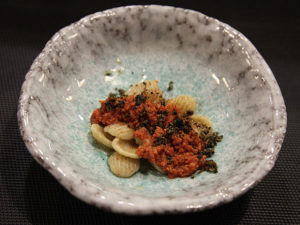First carried to Sicily by Arab merchants around the 12th century, pasta finally made its way to Naples about 300 years ago. For centuries, pasta was only consumed on special occasions by the wealthy and as a rare indulgence by the proletariat. The people of Napoli ate a diet primarily of meats and lots of vegetables, so much so that they were labeled as the mangiafoglia, the leaf-eaters. All that changed in the seventeenth century when macaroni-eating took to the streets of Naples after Spanish misrule caused an increase of poverty and hunger. Through small technological innovations such as the muller and the invention of the mechanical press, the Neapolitans were to produce pasta at greater speeds and lower costs. Pasta became the food of the people, and the Neapolitans went from mangiafoglia, leaf eaters, to mangiamaccheroni, macaroni eaters. Soon after, the whole of Italy was known as the mangiamaccheroni.
Up until the 1700s, the Neapolitans were known as the ‘mangiafoglia,’ which directly translates to leaf-eaters. Emilio Sereni writes in his essay “I napoletani da mangiafoglia a mangiamaccheroni” that ‘foglie’ in the Neapolitan dialect of that time, refers primarily to broccoli. The label of broccoli eaters was well merited as the vegetable was grown all year round in Naples to provide the city with a constant supply (Gentilcore, 33). In 1692, one of Naples poets showed appreciation for the broccoli by exclaiming: “Oh leaf so tasty! Oh leaf so sweet! You are our magnet, and our treat” (Dickie, 151). All parts of the broccoli were eaten; the leaves, stems, and flowers, and they were enjoyed by all members of society from the elite to the lazzaroni (peasants) (Gentilcore, 33).
The Neapolitans also ate a variety of other vegetables as well. There are records that Ospedale dei Pellegrini in Naples, a charitable home called for pilgrims and the homeless, distributed a basic meal of cabbage, squash or turnip soup along with salad and fruit. In the case of religious institutions, they made a virtue of a vegetable-rich diet. Nuns will often be found eating a large quantity and variety of vegetable soups, seasoned with lardo, which is hard bacon fat. In southern Italy, the Poor Clares of Santa Chiara made 461 separate vegetable purchases during the year 1748 – 1749. The nuns of Santa Maria degli Angeli also made similar types of purchases and ate a vegetable soup almost daily—made from cauliflower, chicory, cardoons, escarole, or cabbage—as well as vegetables like squash, eggplant, broccoli rabe, artichokes, and lampaggioli (a small bitter onion) (Gentilcore, 34).
During this period, pasta was perceived as a delicacy commonly eaten by aristocrats and royalty. Ferdinand IV was well known for his passion for pasta that an Irish guest recalled: “He seized it inches fingers, twisting and pulling it about, and cramming it voraciously into his mouth, most magnanimously disdaining the use of either knife, fork, or spoon, or indeed any aid except such as nature had kindly afforded him” (Dickie, 161). Pasta was also so much of a luxury that in 1509 an ordinance was issued to forbade that making of “taralli, susamelli, ceppule, maccarune, trii vermicelli,” and other food products made with dough during times of “war, famine, or a bad season” as to not encroach on production of bread (Capatti, 56 – 57). Even in the ‘birthplace’ of pasta, Sicily, pasta was a costly product. In 1501, due to high prices, pasta was included among the basic foods subject to price control. In the middle of the sixteenth-century, macaroni and lasagne had cost three times as much as bread (Capatti, 57).
Pasta began taking a different role in the Italian diet during the course of the seventeenth century. By the mid 17th century, Naples was experiencing overcrowding due to Spanish misrule and due to corrupt annona officials. The Spaniards had implemented a tax system that further impoverished the already poor rural population, and this drew them into the city of Naples looking for food, housing, and work (Schwartz, 32). Additionally, Naples’ corrupt city magnates and nobles managed an annona, which is a system that is meant to maintain a stable supply of grain, by regulating the supply and demand, through buying and selling grains from farmers in the countryside of the Kingdom of Naples. Unfortunately, the annona officials began to hoard supplies of wheat and speculated on the rapidly rising prices, and the Spanish royal government was too weak to counter their influence (Dickie, 156 – 157). In 1763 as cartloads of grain arrived in the city of Naples, 40,000 peasants from the countryside followed to beg for food on the streets, continuing the overcrowding problem. For months, bread was impossible to find, or it was made from flour so heavily cut with ashes or grit that only the starving could bring themselves to swallow it (Dickie, 157). As hunger became more widespread in the Kingdom of Naples, the city of Naples resembled grotesquely swollen head on top of an emaciated body.
The overpopulation issue caused problems in production and the efficiency of the public market, which then caused the progressive decline of resources that had been the essential ingredients of the popular diet—meat and vegetables (Montanari, 11). In the late 17th century, the price of meat and vegetables increased while the price of wheat fell. This prompted a change in the diet of Neapolitans, with a big shift to carbohydrates. Poor Neapolitans who used to rely on meat and vegetables have now begun to turn to pasta: affordable, filling, and caloric. (Winke, “Mangiamaccheroni: A Surprising Neapolitan Street-Food Tradition”)
Pasta, in particular, grew in popularity due to the fact that, Naples, a rugged city on the Mediterranean coast, like Sicily and the rest of the Campania, was ideal for growing durum wheat due to the climate and soil. The alternating gentle ocean breezes and hot winds from Mount Vesuvius ensured that the pasta would not dry too slowly and risk becoming moldy, or so fast that it would crack or break (Shelke, 23 – 24). Additionally, due to the high demand of crops from the city of Naples, grain turned out to be the most economically rational crop (Dickie, 151). The number of pasta stores in Naples more than quadrupled between 1700 and 1785 as a tribute to the increasing popularity of pasta (Shelke, 24).
Perhaps even more important was the small technological revolution that brought about greater availability of the muller, and technological improvements in manufacture: in the early 1600s, the city witnessed the arrival of the first screw presses for squeezinguni dough through perforated plates to make macaroni, the invention of the mechanical press. This technology has made it possible to produce macaroni and other types of pasta at a considerably lower cost than in the past. For this reason, pasta has become increasingly important in the diet of the city’s poorer classes and encouraged its promotion as a “basic” food (Capatti, 57). If pasta was deemed as one of the many luxury foods up until this stage, it has now, for the first time, become a food of the people, the main meal in the life of the Lazzaroni. From the seventeenth century onwards, the Neapolitans acquired the nickname of “macaroni-eaters,” taking it from the Sicilians, who first embraced the Arab model of dried noodles in the Middle Ages (Montanari, 12). Pasta became cheaper and more abundant, offering a neat solution to Naples’ food shortage.
As pasta became more readily accessible to the city’s poor and became a working-class staple, it began to be served and prepared like most food in Naples: in the open-air and from street market stalls. When Goethe visited the city in 1789, he observed that “macaroni of all kinds … are found everywhere at a low price” (Winner, “Al Dente”). By 1785, Naples had 280 pasta shops, and the city seemed to be laced with pasta hanging over balconies and from frames on the street to dry (Winner, “Al Dente”). Following the drying, the noodles were then boiled in a large cauldron set over an open fire in tiny market stalls. The noodles were flavored with a dab of pork grease, a handful of salt to taste, and hard cheese grated over the top (Winke, “Mangiamaccheroni: A Surprising Neapolitan Street-Food Tradition”). While it may sound picturesque, many aristocrats on the Grand Tour (a coming to age trip of Europe made by young, wealthy, European men), viewed the preparing pasta outdoors to be filthy and unsanitary (Dickie, 145-149).
The Grand Tourists were, on the other hand, very amused by the fact that the urban poor ate their street food, like any proper street food, with their bare hands. Andrea de Jorio, a Neapolitan clergyman and ethnographer, explained in his 1832 ‘La mimica degli antichi investigata nel gestire napoletano’ that to eat macaroni “the Neapolitan way” requires the noodles to be picked up in one fistful, lowered into one’s mouth and “swallowed down in a single, uninterrupted mouthful.” De Jorio further reveals that the macaroni should be eaten “with both hands in such a way that there is no interval between successive mouthfuls, except what is necessary to allow the macaroni to reach the oesophagus.” This method of eating pasta became so famous that watching the lazzaroni eat pasta with their bare hands became a popular Grand Tourist attraction by the 1800s. It also was a spectacle that was largely depicted in paintings, prints, and postcards (Winke, “Mangiamaccheroni: A Surprising Neapolitan Street-Food Tradition”).
During the Grand Tours, many tourists arranged shows of the lazzaroni’s pasta eating for entertainment. Tossing a coin or two at the lazzaroni, the street beggars, would create a rush to the nearest maccheroni stand to consume the macaroni in their distinctive way. One night while riding through a market, John Lawson Stoddard, an American visitor to Naples, wrote that he had stopped to purchase 20 plates of macaroni in order to watch the Lazzaroni eat them. “The instant that one wretched man received a plate a dozen others jumped for it; [they] grabbed handfuls of the steaming mass, and thrust the almost scalding mixture down their throats,” he wrote. “I had expected to be amused, but this mad eagerness for common food denoted actual hunger.” The spectacle, as Stoddard discovered, was a poignant testimony to the poverty that has impacted Naples’ working-class families for generations (Braun “Eating Spaghetti by the Fistful Was Once a Neapolitan Street Spectacle”).
Despite the displays of poverty throughout Napoli, pasta the food item that helped the Neapolitans survive through periods of famine. According to “Pasta: the Story of a Universal Food,” a report from 1758 reveals that the volume of raw macaroni material consumed in Naples at that time was roughly 1,132 tons, which would yield roughly the same weight of dry pasta. It is estimated that this to amount to no more than about thirty-one pounds per person per year—that is, only a little more than the average per capita consumption in Italy today. When adding the context of the poverty of that time, the figure is remarkably high (Serventi, 123 – 124). Even when famine and plague hit in the late eighteenth century, Neapolitans didn’t die in large numbers as others did elsewhere (Winner, “Al Dente”). Pasta had saved the city.
Soon, with the unification of Italy in 1860, the label of “macaroni-eaters” had acquired a broader meaning, representative not only of Neapolitans but of Italians in general. In the 1930s, in an attempt to make the country more self-sufficient, Mussolini initiated the growing of durum wheat in central and northern Italy. Factories in the north of Italy began making pasta, and electric drying tunnels replaced sea and volcanic breezes. Naples became less essential in the production of pasta, and today the province of Campania is the country’s sixth-largest pasta producer (Kummer, “Pasta”). Now, all across Italy, Italians enjoy a more unified cuisine of pasta. Additionally, outside Italy, the stereotype of the macaroni eater was already perceived as part of the Italian character in the broadest sense. With the emigration of Italians in the nineteenth century, the consumption of pasta was seen as a distinctive element of the Italian “difference” (Montanari, 11).
Many nineteenth-century Italian poets have since gone on to show their appreciation for pasta in many of their musical compositions. Mela’s Don Matteo from Verona sings:
“Oh dearest, dear maccheroni, exquisite victual, beloved food, our bellies are prepared to celebrate you!… Now they are ready and how thick they are! I will surely swell the sweet Reginella!” (Parzen, 81).
In Bologna, Maritini writes,
“How delicious are maccheroni! O you who hear, o you who eat…” (Parzen, 82)
Finally, in an anonymous poem published in Milan:
“One cannot reach any higher nor can one hope for anything greater than the great consolation of eating maccheroni… Neapolitans, Genovese, Sicilians and Milanese and every other nationality. Everyone loves maccheroni” (Parzen, 82).
All these poems and lyrics represent the culture of pasta, where the first traces of a truly national identity begin to arise in the life of Risorgimento Italy.
Through Spanish misrule and through corrupt annona officials, famine and poverty were brought to the city of Naples, where meat and vegetables, the Neapolitan’s predominant diet was no longer readily available. Fortunately, through the innovation of the mechanical press, Naples became a producer of affordable pasta, and its people were able to power through moments of economic turmoil that risk famine and hunger. The people of Naples soon retired its label of the leaf-eaters to now obtain the label of macaroni-eaters with a characteristic way of eating pasta by the fistful. However, soon enough, ‘macaroni-eaters’ becomes an Italian identity. The rest of Italy may not have much in common with the Neapolitans. They differ in language, traditions, wines, and gastronomy, except for on aspect which all Italians culinarily embrace: pasta.

